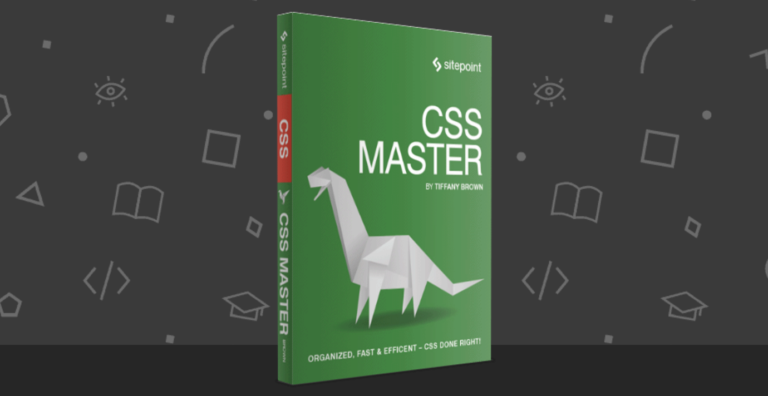Learn about CSS Architecture: Atomic CSS

The following is an extract from our book, CSS Master, written by Tiffany Brown. Copies are sold in stores worldwide, or you can buy it in ebook form here.
If BEM is the industry darling, Atomic CSS is its rebellious maverick. Named and explained by Thierry Koblentz of Yahoo in his 2013 piece, Challenging CSS Best Practices, Atomic CSS uses a tight library of class names. These class names are often abbreviated and divorced from the content they affect. In an Atomic CSS system, you can tell what the class name does; but there is no relationship between class names—at least, not those used in the stylesheet—and content types.
Let’s illustrate with an example. Below is a set of rules in what we might call a conventional CSS architecture. These rule sets use class names that describe the content to which they apply: a global message box, and styles for “success,” “warning,” and “error” message boxes:
.msg {
background-color: #a6d5fa;
border: 2px solid #2196f3;
border-radius: 10px;
font-family: sans-serif;
padding: 10px;
}
.msg-success {
background-color: #aedbaf;
border: 2px solid #4caf50;
}
.msg-warning {
background-color: #ffe8a5;
border-color: #ffc107;
}
.msg-error {
background-color: #faaaa4;
border-color: #f44336;
}To create an error message box, we’d need to add both the msg and msg-error class names to the element’s class attribute:
<p class="msg msg-error">An error occurred.</p>Let’s contrast this with an atomic system, where each declaration becomes its own class:
.bg-a {
background-color: #a6d5fa;
}
.bg-b {
background-color: #aedbaf;
}
.bg-c {
background-color: #ffe8a5;
}
.bg-d {
background-color: #faaaa4;
}
.bc-a{
border-color: #2196f3;
}
.bc-b {
border-color: #4caf50;
}
.bc-c {
border-color: #ffc107;
}
.bc-d {
border-color: #f44336;
}
.br-1x {
border-radius: 10px;
}
.bw-2x {
border-width: 2px;
}
.bss {
border-style: solid;
}
.sans {
font-style: sans-serif;
}
.p-1x {
padding: 10px;
}That’s a lot more CSS. Let’s now recreate our error message component. Using Atomic CSS, our markup becomes:
<p class="bw-2 bss p-1x sans br-1x bg-d bc-d">
An error occurred.
</p>Our markup is also more verbose. But what happens when we create a warning message component?
<p class="bw-2 bss p-1x sans br-1x bg-c bc-c">
Warning: The price for that item has changed.
</p>Two class names changed: bg-d and bc-d were replaced with bg-c and bc-c. We’ve reused five rule sets. Now, let’s create a button:
<button type="button" class="p-1x sans bg-a br-1x">Save</button>Hey now! Here we’ve reused four rule sets and avoided adding any more rules to our stylesheet. In a robust atomic CSS architecture, adding a new HTML component such as an article sidebar won’t require adding more CSS (though, in reality, it might require adding a bit more). Atomic CSS is a bit like using utility classes in your CSS, but taken to the extreme. Specifically, it:
- keeps CSS trim by creating highly granular, highly reusable styles, instead of a rule set for every component
- greatly reduces specificity conflicts by using a system of low-specificity selectors
- allows for rapid HTML component development once the initial rule sets are defined
However, Atomic CSS is not without controversy.
The Case Against Atomic CSS
Atomic CSS runs counter to just about everything we’ve been taught on writing CSS. It feels almost as wrong as sticking style attributes everywhere. Indeed, this is one of the major criticisms of the Atomic CSS methodology: it blurs the line between content and presentation. If class="fl m-1x" floats an element to the left and adds a ten-pixel margin, what do we do when we no longer want that element to float left?
One answer, of course, is to remove the fl class from our element. But now we’re changing HTML. The whole reason behind using CSS is so that markup is unaffected by presentation and vice versa. (We can also solve this problem by removing the .fl {float: left;} rule from our stylesheet, although that would affect every element with a class name of fl). Still, updating the HTML may be a small price to pay for trimmer CSS.
In Koblentz’s original post, he used class names such as .M-10 for margin: 10px and .P-10 for padding: 10px. The problem with such a naming convention should be obvious. Changing to a margin of five or 20 pixels means we’d need to update our CSS and our HTML, or risk having class names that fail to accurately describe their effect.
Using class names such as p-1x, as done in this section, resolves that issue. The 1x part of the class name indicates a ratio rather than a defined number of pixels. If the base padding is five pixels (that is, .p-1x {padding: 5px;}), then .p-2x would set ten pixels of padding. Yes, that’s less descriptive of what the class name does, but it also means that we can change our CSS without updating our HTML, or without creating a misleading class name.
An atomic CSS architecture doesn’t prevent us from using class names that describe the content in our markup. You can still add .button-close or .accordion-trigger to your code. Such class names are preferable for JavaScript and DOM manipulation.
BEM versus Atomic CSS
BEM works best when you have a large number of developers building CSS and HTML modules in parallel. It helps to prevent the kind of mistakes and bugs that are created by sizable teams. It scales well, in part, because the naming convention is descriptive and predictable. BEM isn’t only for large teams; but it works really well for large teams.
Atomic CSS works better when there is a small team or a single engineer responsible for developing a set of CSS rules, with full HTML components built by a larger team. With Atomic CSS, developers can just look at a style guide—or the CSS source—to determine which set of class names they’ll need for a particular module.
Frequently Asked Questions about Atomic CSS
What is the main difference between Atomic CSS and traditional CSS?
Atomic CSS, also known as functional CSS, is a methodology where styles are broken down into atomic, or indivisible, pieces. Each class does one thing and one thing only, which can be as simple as setting a margin or changing a font color. Traditional CSS, on the other hand, often involves creating specific classes for specific elements, which can lead to bloated stylesheets and specificity wars. Atomic CSS promotes reusability and can lead to cleaner, more maintainable code.
How does Atomic CSS improve performance?
Atomic CSS can significantly improve performance by reducing the size of your stylesheets. Since each class does only one thing, there’s less repetition in your CSS. This can lead to smaller file sizes, which means faster load times for your users.
Is Atomic CSS suitable for large-scale projects?
Yes, Atomic CSS can be particularly beneficial for large-scale projects. It promotes consistency and reusability, which can make your codebase easier to maintain. However, it does require a shift in mindset and may not be suitable for every team or project.
What are some common criticisms of Atomic CSS?
Some critics argue that Atomic CSS can lead to verbose and hard-to-read HTML, as each element can have many classes. Others worry that it breaks the separation of concerns, as styling information is now mixed with your markup. However, proponents of Atomic CSS argue that these concerns are outweighed by the benefits of cleaner, more maintainable code.
How can I start using Atomic CSS in my projects?
There are several libraries available that can help you get started with Atomic CSS, such as ACSS, Tachyons, and Tailwind CSS. You can also start incorporating Atomic CSS principles into your own stylesheets by breaking down your styles into atomic, reusable classes.
Can Atomic CSS work with pre-processors like SASS or LESS?
Yes, Atomic CSS can work with CSS pre-processors like SASS or LESS. However, it’s important to remember that Atomic CSS is a methodology, not a specific tool or framework. It’s about how you structure and organize your CSS, not necessarily about the tools you use to write it.
Is Atomic CSS compatible with CSS frameworks like Bootstrap?
Yes, Atomic CSS can be used alongside CSS frameworks like Bootstrap. However, one of the main benefits of Atomic CSS is that it can reduce the need for large, bloated frameworks by promoting reusability and simplicity.
How does Atomic CSS handle responsive design?
Atomic CSS can handle responsive design by using classes that target specific screen sizes. For example, you might have a class that sets a margin on large screens and another class that sets a different margin on small screens.
Can Atomic CSS be used with JavaScript frameworks like React or Vue?
Yes, Atomic CSS can be used with JavaScript frameworks like React or Vue. In fact, some developers find that Atomic CSS complements these frameworks well, as both promote a component-based architecture.
What are some resources for learning more about Atomic CSS?
There are many resources available for learning more about Atomic CSS. Some recommended ones include the ACSS website, CSS-Tricks, and various articles and tutorials on Medium and other coding blogs.
Tiffany B. Brown is a freelance web developer and technical writer based in Los Angeles. Brown offers web development and consulting services to larger agencies and small businesses. A former member of the Opera Software developer relations team, Brown is also co-author of SitePoint's JumpStart HTML5 book. She sporadically writes about web development technology on her blog. You can follow her on Twitter at @webinista.

Published in
·CMS & Frameworks·Development Environment·Frameworks·Laravel·News & Opinion·PHP·Standards·Symfony·Web·March 3, 2017






